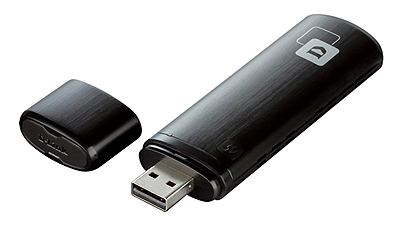D-Link
Corporation, one of the world's largest network equipment
manufacturers, has introduced Wireless AC1200 Dual Band USB Adapter
supporting 802.11ac draft standard. Although first 802.11ac devices were
offered on the market six months ago and the first company in the world
that presented a prototype of 802.11ac router was Buffalo at January's
Consumer Electronics Show in Las Vegas, the product of D-Link really
opens up the market for this kind of equipment. The adapter enables the
user to transfer data wirelessly at speeds about 1 Gbps, which is ideal
e.g. for flawless HD video streaming.

D-LINK AC 1200 adapter supporting 802.11ac draft.
Although at present the price is rather high (about $90, several times more than the cost of popular 802.11n devices), everyone can expect that D-Link will be followed by other manufactures, including TP-Link,
and the cost of such solutions in 2013 will not be a barrier for most potential users. [dlink.com]
Although at present the price is rather high (about $90, several times more than the cost of popular 802.11n devices), everyone can expect that D-Link will be followed by other manufactures, including TP-Link,
and the cost of such solutions in 2013 will not be a barrier for most potential users. [dlink.com]
The
"Gigabit Wi-Fi" is based both on solutions used in the IEEE 802.11n
standard and new ones, which together allow for the unprecedented
throughput. The devices compliant with the future 802.11ac standard (the
approval of its final specification is expected in late 2013, the
current devices are based on draft 4.0) will operate in the 5 GHz band,
at data transfer rates at the level of 1 Gbps (multi-station WLAN
throughput). However, there are plans for 2015 to launch first chipsets
enabling wireless transmission transfer rates up to 7 Mbps, previously
unimaginable for this medium.
Such data rates will be possible with the use of high-density 256 QAM modulation, extra-wide 160 MHz channels, and up to 8 MIMO spatial streams. Additionally, Multi-user MIMO (MU-MIMO) technology will allow multiple clients (each with one or more antennas) to transmit or receive independent data streams simultaneously. In the case of using several antennas, the Space Division Multiple Access (SDMA) well known from MIMO applications in n standard can provide higher throughput as well. The 802.11ac chipsets supporting MU-MIMO are expected in 2014.

Comparison of data transfer rates provided by 802.11ac and 802.11n solutions
[dailywireless.com]
[dailywireless.com]
Other
leading manufacturers, such as Netgear, Cisco/ Linksys, also expand
their offerings with 802.11ac devices. It is expected that in 2013 -
along with the official approval of the standard - the market will also
offer laptops with wireless cards in this this technology. The response
of smartphone industry can be even quicker - in late 2013 probably 70%
of smartphones will be equipped with the appropriate chipsets. The next
two years will show how quickly the 802.11ac standard penetrates the
WLAN market. The 802.11n standard, approved in 2009, and winning real
popularity in 2012, would have to go to early retirement. So, it seems
that wireless standard developers and equipment manufacturers are
slightly ahead of the current needs of the users.
No comments:
Post a Comment